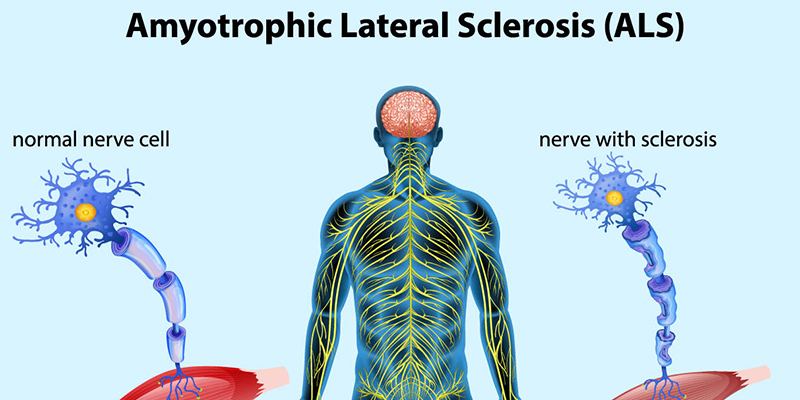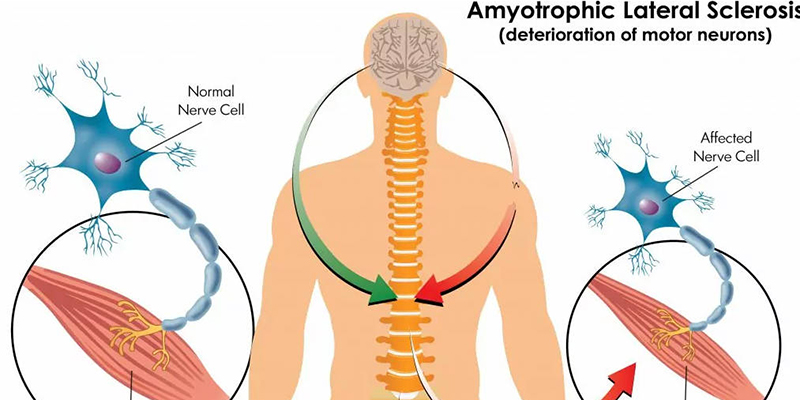Understanding Amyotrophic Lateral Sclerosis (ALS)
Amyotrophic Lateral Sclerosis (ALS), commonly known as Lou Gehrig's disease, is a progressive neurological disorder that primarily targets motor neurons in the brain and spinal cord. As these neurons deteriorate, individuals face a gradual decline in muscle control, resulting in significant physical challenges. The implications of ALS extend far beyond the individual diagnosis, affecting families, friends, and communities, thus highlighting the urgent necessity for increased awareness and empathy.
Amyotrophic Lateral Sclerosis (ALS), commonly known as Lou Gehrig's disease, is a progressive neurological disorder that primarily targets motor neurons in the brain and spinal cord. Individuals gradually decline muscle control as these neurons deteriorate, resulting in significant physical challenges. The implications of ALS extend far beyond the individual diagnosis, affecting families, friends, and communities, thus highlighting the urgent necessity for increased awareness and empathy.

Despite the disease's profound ramifications, many people remain primarily uninformed about its complexities and the variety of symptoms it presents. This article aims to demystify ALS, focusing on its symptoms to foster a better understanding among readers. By increasing awareness of ALS and its effects, we strive to promote advocacy and support for those enduring this challenging condition. This sets the stage for more in-depth discussions in the following sections.
What Is ALS?
Amyotrophic Lateral Sclerosis (ALS) is characterized as a progressive neurodegenerative disorder that affects nerve cells within the brain and spinal cord, which ultimately leads to the gradual loss of muscle control and function. The term "Amyotrophic" is derived from Greek origins: "a" (meaning no or without), "myo" (about muscle), and "trophic" (about nourishment), signifying a lack of nourishment to the muscles. The word "Lateral" points to the region in the spinal cord where the nerve cells responsible for voluntary muscle movement are located, while "sclerosis" refers to the scarring or hardening of these areas.
Historically, ALS captured public attention following the diagnosis of baseball icon Lou Gehrig in the 1930s, leading to the moniker "Lou Gehrig's disease." In the decades since, the disease has been the focus of extensive research, though its precise causes remain elusive.
From a neurological perspective, ALS disrupts the functioning of motor neurons, which transmit essential signals from the brain to the muscles, ultimately culminating in muscle atrophy and weakness. As the disease progresses, people may struggle with movement, speech, swallowing, and even breathing as the muscles responsible for respiration weaken. Interestingly, cognitive functions tend to remain intact, adding layers of complexity to the emotional and psychological consequences experienced by patients.
In terms of prevalence, ALS impacts approximately 2 out of every 100,000 individuals globally. It predominantly affects adults, with most cases emerging between 40 and 70. Furthermore, men face a slightly higher risk of developing the disease compared to women. While anyone can be affected by ALS, familial ALS represents only about 5-10% of total cases, indicating that both genetic and environmental elements play a role in its aetiology. A comprehensive understanding of ALS is crucial for the patients and families involved in advancing research efforts and enhancing therapeutic interventions.
The Mechanism Behind ALS
The progression of Amyotrophic Lateral Sclerosis (ALS) hinges on the gradual degeneration of motor neurons, which are pivotal for voluntary muscle control. The disease impacts both upper motor neurons, which initiate signals in the brain, and lower motor neurons, situated in the spinal cord and brainstem, that carry these signals to the muscles. As the disorder advances, neurons die, disrupting vital communication paths between the brain and muscles.

The degeneration of upper motor neurons triggers symptoms, including muscle weakness and stiffness, while the loss of lower motor neurons leads to atrophy and twitching of the muscles. Once lower motor neurons begin to fail, they can no longer adequately stimulate muscle contractions, which results in increasingly pronounced weakness. This double loss of neuronal function is integral to the hallmark symptoms of ALS, which encompass challenges in speaking, swallowing, and, ultimately, breathing. Recognizing the pathophysiological transformations affecting motor neurons in ALS is crucial, as these changes are directly related to the debilitating symptoms that patients endure. The complex mechanisms underlying neuron degeneration highlight the severity of muscle control impairment, affirming the imperative to raise awareness, advocate for ongoing research, and bolster support initiatives for those burdened by this condition.
Symptoms Of ALS
Early Symptoms
Amyotrophic Lateral Sclerosis (ALS) often begins with subtle signs, making the early recognition of symptoms essential for timely diagnosis and intervention. The most frequently observed initial symptoms include persistent muscle weakness and fatigue, often described as a sensation of heaviness in the limbs or the gradual onset of difficulty performing previously manageable daily activities. For instance, an individual may increasingly struggle with lifting objects or ascending stairs. It’s important to note that symptom variability exists among individuals; one person may first notice weakness primarily in their hands, while another may experience it first in their legs.
Identifying these early signs is critical, as it can expedite consultation with healthcare professionals who can conduct the requisite evaluations. Family members and friends play a vital role in recognizing these subtle changes and encouraging affected individuals to seek medical advice promptly. Delays in diagnosis could hinder access to essential resources and support systems that can drastically enhance a patient's quality of life.
Progressive Symptoms
As ALS advances, initial symptoms tend to escalate into more severe challenges. Patients frequently report muscle spasms and involuntary twitching, contributing to further discomfort. Communication becomes troublesome; individuals may speak slowly or slur their words, imposing a significant emotional burden on the individual and their loved ones. In addition, swallowing difficulties often arise, leading to anxiety and fear during meals and resulting in dietary changes.
The shift from early symptoms to more profound challenges is not purely a physical decline; the emotional and psychological repercussions are equally pronounced. Patients may grapple with frustration and helplessness in the face of waning independence. Family members commonly encounter a spectrum of emotions, including sadness, frustration, and the instinct to provide unwavering support. Therefore, within the framework of ALS, the symptoms extend beyond medical concerns to encompass a broader emotional landscape, necessitating compassion and understanding from everyone involved.
At each phase of ALS, awareness, early recognition, and open lines of communication remain crucial in effectively managing the disease and supporting those affected.
Diagnosis Of ALS
Diagnosing Amyotrophic Lateral Sclerosis (ALS) requires a detailed assessment by healthcare professionals. Initially, clinicians comprehensively review the patient's medical history alongside a physical examination. Confirming a diagnosis of ALS necessitates several tests, including electromyography (EMG), to evaluate electrical activity within the muscles and nerve conduction studies. Diagnostic imaging methods like MRI are also employed to exclude other conditions that may mimic ALS symptoms, such as multiple sclerosis. Ruling out alternative diagnoses is pivotal, as a definitive ALS diagnosis typically necessitates identifying both upper and lower motor neuron signs in the patient.
Current Treatments And Research
The primary medication currently approved for ALS is Riluzole, which has demonstrated the capacity to slow disease progression and extend survival. Alongside Riluzole, edaravone is another option that assists in slowing functional decline for certain patients. Ongoing research is dedicated to exploring new therapeutic avenues, including gene therapies and neuroprotective agents, providing hope for improved treatment outcomes. Moreover, continuous support systems like physical therapy and assistive devices are vital in enhancing ALS patients' quality of life, underscoring the need for a robust support network as they navigate their journey.
The Path Forward
Understanding ALS is critical in cultivating empathy and extending support for those impacted by this intricate disease. We invite readers to actively seek community resources for patients and their families. Advocacy efforts and increased awareness can profoundly affect lives, making our collective endeavours indispensable in the fight against ALS.







